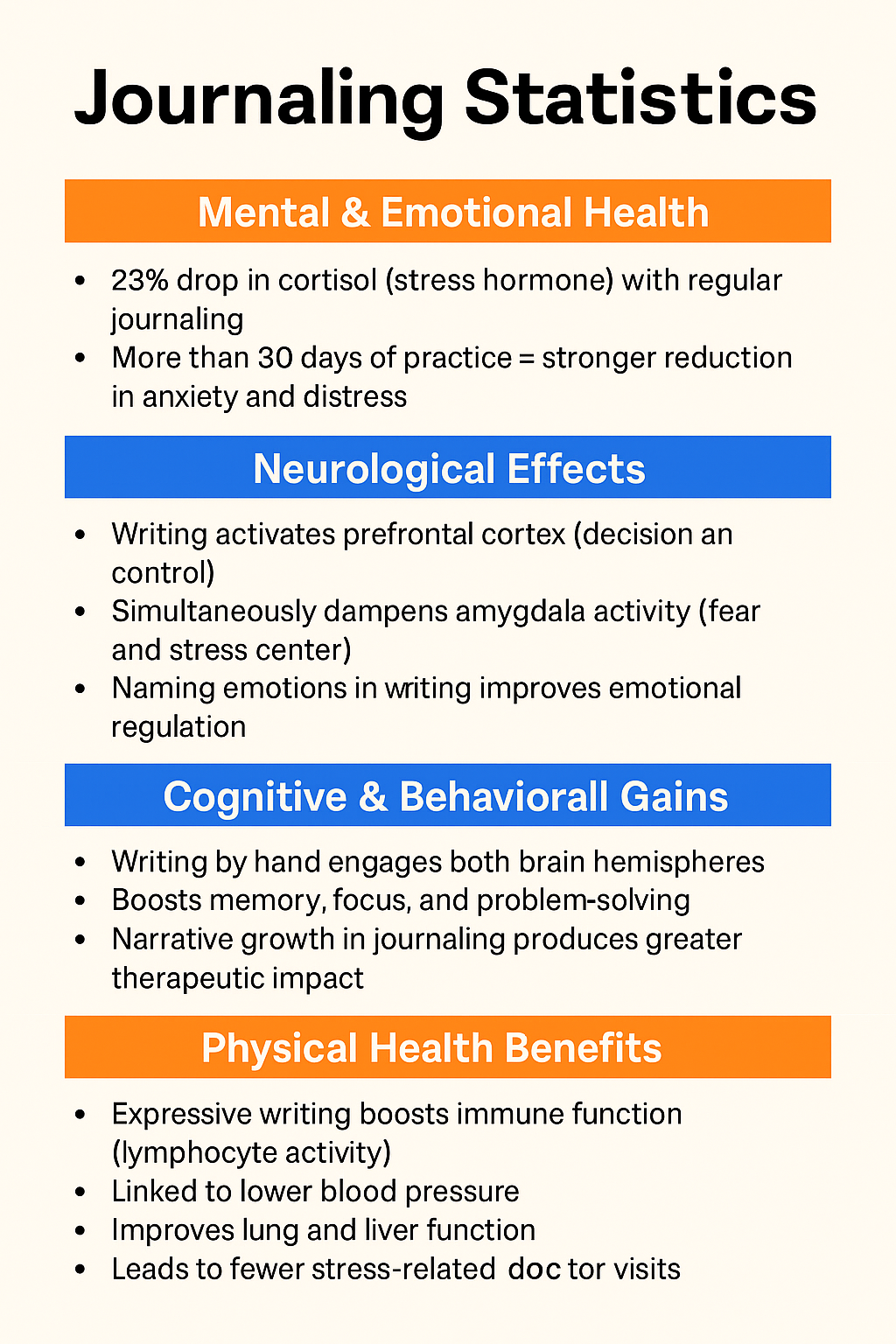Physical Address
304 North Cardinal St.
Dorchester Center, MA 02124
Physical Address
304 North Cardinal St.
Dorchester Center, MA 02124


Sam had tried everything—therapy, meditation apps, even a brief stint with antidepressants.
But it was a simple notebook that finally broke through his years of anxiety and depression.
“I thought journaling was not for me,” he admits. “I had no idea it could literally rewiring my brain.”
Sam isn’t alone.
Millions of people worldwide are discovering that the simple act of putting pen to paper isn’t just cathartic—it’s a scientifically-proven therapeutic intervention that creates measurable changes in both brain structure and overall health.
From reducing cortisol levels to strengthening neural pathways for resilience, journaling represents one of the most accessible yet powerful tools we have for mental wellness.
The story begins in the 1980s with Dr. James Pennebaker, a psychology professor who accidentally revolutionised our understanding of emotional healing.
Pennebaker’s breakthrough came through a deceptively simple experiment.
He asked participants to write about their most stressful or traumatic experiences for just 15-20 minutes over three to five consecutive days.
The results stunned the scientific community.
Participants didn’t just feel better psychologically—they showed dramatic improvements in physical health. Doctor visits dropped, immune function improved, and stress-related symptoms decreased significantly. Pennebaker had stumbled upon what would become known as Emotional Disclosure Theory.
This is the idea that holding back thoughts and feelings about powerful emotional experiences is physically and psychologically taxing.
“The act of concealing our deepest thoughts and feelings requires tremendous energy. When we release this burden through writing, we free up resources for healing and growth.”
Pennebaker
His protocol was elegantly simple.
No special training required.
No expensive equipment.
Just a pen, paper, and the courage to face difficult emotions on the page.

Modern neuroscience has revealed exactly why Pennebaker’s approach works so powerfully.
When we write about emotional experiences, we activate a sophisticated dance between two critical brain regions: the prefrontal cortex (PFC) and the amygdala.
The PFC serves as your brain’s executive center, responsible for decision-making, emotional regulation, and self-control. The amygdala, meanwhile, acts as your internal alarm system, constantly scanning for threats and triggering stress responses. In a healthy brain, the PFC keeps the amygdala in check. But trauma, chronic stress, and emotional upheaval can disrupt this delicate balance.
Here’s where journaling becomes neurological medicine. The act of verbally labeling emotions—what scientists call “affect labeling”—activates the right ventrolateral prefrontal cortex while simultaneously dampening amygdala activity. In essence, writing helps your rational brain calm your emotional brain.
But perhaps most remarkably, neuroimaging studies have discovered that individual neural responses during affect labeling can predict who will benefit most from expressive writing months later.
“Your brain’s existing capacity for emotional regulation appears to determine how much journaling will help you,” explains one researcher. This finding transforms journaling from a generic self-care practice into a potentially targeted clinical intervention.
Researcher observation
The changes go beyond immediate emotional regulation.
Consistent journaling promotes neuroplasticity—your brain’s remarkable ability to form new neural connections.
Each time you process difficult emotions through writing, you’re literally strengthening the neural pathways associated with resilience, emotional regulation, and positive thinking.
Not all journaling is created equal. Research has identified three distinct approaches, each with unique psychological and neurological effects:
This is Pennebaker’s original protocol, designed for working through trauma, grief, or intense emotional experiences.
The process involves writing continuously about a stressful event, allowing thoughts and feelings to flow without censoring or editing.
“Write about the most stressful or traumatic experience of your life. Really let go and explore your deepest thoughts and feelings about this experience. You might connect it to your childhood, your relationships, your career, or other important aspects of your life.”
Expressive writing activates the prefrontal cortex while dampening the amygdala, literally helping your brain process and integrate difficult experiences. The caveat? It can initially increase emotional distress before providing long-term benefits. Think of it as emotional surgery—temporarily painful but ultimately healing.
This approach focuses on consciously identifying and writing about positive experiences, relationships, and aspects of life for which you feel grateful.
“Write about three things that went well today. For each event, describe what happened, why you think it went well, and how it made you feel. What role did you play in making this positive event happen?”
Neurologically, gratitude journaling activates brain regions associated with reward and learning, particularly the medial prefrontal cortex. It also promotes the release of dopamine and serotonin—your brain’s natural antidepressants. Interestingly, research suggests the benefits stem more from reducing negative emotional language than increasing positive words, highlighting the power of attention redirection.
This practice involves non-judgmental observation and recording of present-moment thoughts, feelings, and sensations as they arise.
“Right now, what am I thinking? What am I feeling in my body? What emotions are present? Write about these experiences without trying to change them—simply notice and describe what’s happening in this moment.”
Mindfulness journaling enhances what psychologists call “meta-cognitive awareness”—the ability to think about your thinking. This creates psychological distance between you and your thoughts, reducing rumination and fostering self-compassion.
The benefits of journaling extend far beyond mental wellness into measurable physical health improvements. Regular practitioners show up to a 23% reduction in cortisol, the body’s primary stress hormone. This reduction has cascading effects throughout the body.
The immune system responds particularly well to expressive writing. Studies document increased lymphocyte activity—the white blood cells responsible for fighting infection and disease. Participants in journaling studies show improved cardiovascular health, including lower blood pressure and better heart rate variability. Even sleep improves, with gratitude journaling specifically helping people fall asleep faster and experience fewer nighttime disruptions.
“When we process emotional experiences through writing,” explains one researcher, “we reduce the chronic stress response that undermines physical health. The mind-body connection isn’t metaphorical—it’s measurable.”
Despite overwhelming positive evidence, journaling isn’t universally beneficial. Research has identified several ways the practice can backfire, typically when writing becomes what psychologists call “rumination on paper.”
The difference lies in approach.
Therapeutic journaling involves active problem-solving, meaning-making, and perspective-taking.
Harmful journaling involves passive venting, self-obsession, and circular thinking that reinforces negative patterns rather than breaking them.
Warning signs include:
The key insight from research on failed journaling interventions is this: the therapeutic effect isn’t inherent in the act of writing—it’s contingent on the process and mindset. Writing must be paired with genuine curiosity, self-compassion, and a willingness to consider new perspectives.
Based on decades of research, several principles emerge for effective therapeutic journaling:
Timing and Consistency: The most robust benefits appear after 15-20 minutes of writing, 3-5 times per week, sustained for at least 30 days. Single sessions can provide temporary relief, but lasting change requires consistent practice.
The Right Mindset: Approach your writing with what researchers call “constructive self-focus”—honest examination of experiences combined with genuine curiosity about growth and learning opportunities.
“As I write about this difficult experience, what am I learning about myself? What strengths am I discovering? How might this challenge be preparing me for future situations?”
Balanced Content: Mix free-writing sessions (allowing thoughts to flow without editing) with structured prompts designed to promote specific therapeutic outcomes like gratitude, self-compassion, or problem-solving.
Integration Focus: Rather than simply venting emotions, actively look for patterns, connections, and insights that can inform future decisions and behaviors.
“Looking back at my recent journal entries, what themes do I notice? What patterns in my thinking or behavior are becoming clear? What would I want to tell someone else going through a similar experience?”
Mental health professionals increasingly recognise journaling as a powerful adjunct to traditional therapy.
In CBT, or ACT matrix formation, journaling helps clients track thought patterns and behavioural triggers between sessions.
For trauma therapy, writing offers a less intimidating entry point for clients who struggle to verbalise their experiences initially.
Digital platforms are making therapeutic journaling more accessible and structured.
Apps provide guided prompts, track mood patterns over time, and some even use AI to identify concerning language patterns that might warrant professional attention.
Current research gaps point toward exciting future developments. Studies need better representation across diverse populations, ages, and cultural backgrounds. Long-term longitudinal studies will help us understand how journaling benefits evolve over years rather than months.
Perhaps most intriguingly, the relationship between individual neural responses and journaling effectiveness suggests we may soon be able to personalize therapeutic writing approaches based on brain imaging or other biomarkers.
Technology integration continues expanding possibilities. AI-guided prompts can adapt to individual needs and progress. Virtual reality environments might enhance the therapeutic writing experience. Wearable devices could trigger journaling prompts based on physiological stress indicators.
As research continues revealing the mechanisms behind journaling’s healing power, one element emerges as particularly crucial: the human need for coherent narrative. When traumatic or difficult experiences occur, they often fragment our sense of story—about ourselves, our relationships, and our place in the world.
Perhaps the most profound insight from journaling research isn’t about emotional expression or stress reduction, but about story reconstruction. The act of writing forces our minds to organize chaotic, fragmented experiences into linear, coherent narratives. We become the authors of our own healing stories.
This suggests that the therapeutic power of journaling might be optimized by embracing classic story elements: character development, conflict resolution, and meaning-making. Rather than simply recording events or emotions, we might benefit from approaching our journals as ongoing narratives of growth and transformation.
“If my life were a story, what chapter am I currently writing? What challenges is my character facing, and how might they grow from these experiences? What would I want this character to learn or discover?”
The most effective journal entries in research studies often showed narrative progression—participants who demonstrated “some kind of growth” in their writing, including changes in perspective or shifts from first-person to more objective language, benefited more than those whose writing remained static.
“A year from now, when I look back at this difficult period, what story will I tell about how I navigated these challenges? What would I want that story to say about my resilience, my values, and my capacity for growth?”
This narrative approach aligns with emerging research on post-traumatic growth, suggesting that healing isn’t just about returning to baseline but about integrating difficult experiences into a more complex, resilient sense of self and story.
Right now, there is plenty of reasons for our collective and individual fragmented attention.
Worse still, the constant supply of digital stuff ends up with a feeling of disconnected experiences.
Perhaps the profound healing power of journaling lies not just in its ability to regulate emotions or reduce stress, but in its capacity to help us reclaim our roles as the authors of our own stories.
Because when we write, we don’t just process the past—we actively construct the future story beats of our lives.
Your pen isn’t just a tool for emotional expression. It’s an instrument for story creation, meaning-making, and ultimately, healing transformation. The question isn’t whether you have a story worth telling—it’s whether you’re ready to pick up the pen and start writing it.
If you’re recovering from an emotionally abusive relationship, try this book on therapeutic writing.